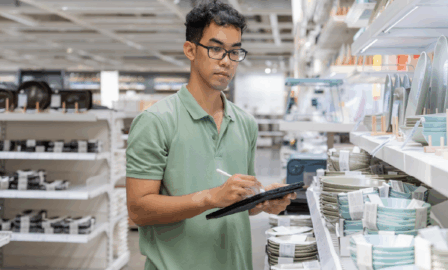Key Takeaways from Home Delivery World 2023
Clarkston’s Aley Saleh and Dave Treadaway recently attended Home Delivery World 2023 in Philadelphia, Pennsylvania. Retail supply chain professionals and leaders gathered to discuss the latest trends and challenges in retail manufacturing, logistics, and supply chain, as well as share perspectives and ideas about the future of the industry. Below, Aley and Dave highlight four key takeaways from Home Delivery World 2023.
Home Delivery World 2023 Takeaways
1. Last Mile Delivery & Visibility
The customer wants engagement and real-time feedback. Customers don’t only care about product quality, but they also care about delivery quality and the next-level service you can provide. We will see an increase in real-time updates and the use of AR & VR to support complex deliveries – how to move products through narrow spaces, how to deliver and set up products, how to use products – ultimately to ensure the customer likes it so they’re less likely to make a return.
For all retailers, visibility is key, but it changes depending on the service and company. Reliability and predictability are key to customer satisfaction, especially for perishable items or where the client needs to be present for delivery. One example discussed at Home Delivery World was Total Wine and More, which is using last-mile delivery partners to plan deliveries and reach their customers in complex areas where state liquor rules are different and country liquor sales can vary. This is a great reminder to ensure you have a partnership in place that provides the opportunity to gain multiple data points to understand your delivery routes for better optimization.
2. Automation & Advanced Technology
We’re seeing automation and advanced technology everywhere, and it’s now making its way to the warehouse. With automation and advanced reporting capabilities, we can now have a better understanding of the difference between our highest performers and our lowest performers. We can learn through their patterns to help improve human capabilities, picking locations, and warehouse design.
Through automation in the warehouse, companies can increase the number of orders picked and the accuracy of each pick, leading to fewer returns and unsatisfied customers. We are also seeing automation extend from the warehouse and to the customer’s door. Through automation, customers are now receiving more real-time delivery status notifications. While the use of notifications is providing more visibility to the customer, we need to also be mindful of the notifications that are being sent, as notifications aren’t needed at every step along the journey but are key in communicating delays, issues, and estimated time of arrival.
3. Supply Chain Sustainability
Customers are increasingly prioritizing sustainability, and they desire to see companies also pursue sustainable goals and practices. They’re even going one step further and asking for not just the policy but the proof, too, which is holding companies more accountable. To meet the needs of the conscious customer, companies need to be proactive in their sustainability approach and look to their supply chain partners for support. How do your company’s goals, as well as your supply chain partners’ goals, tie into your sustainability efforts?
While there will continue to be a push for more sustainable practices across the supply chain, there will also be new considerations to take into account. Some of the new sustainability options that were highlighted were using biodegradable packaging, recycling unconventional items such as furniture, and enabling QR codes on shipping bills and documents. While we are seeing alternative approaches to sustainability, we are still seeing the reoccurring theme of ensuring you are forecasting accurately and streamlining your supply chain efficiently.
4. Supply Chain Resilience
We are continuing to see manufacturers and suppliers shift away from a “just in time” inventory model as supply chain disruptions, labor shortages, and economic challenges continue to increase, and we expect to see a continued imbalance of supply and demand for at least another 18 to 24 months. One way that retailers can increase their supply chain resiliency is by diversifying their transportation suppliers, with more and more companies onboarding new parcel carriers and looking for new solutions to increase capacity.
When it comes to supplier diversity, some questions our clients should be asking themselves are:
- Do we have the framework in place to support our business?
- What are ways we can get ahead of internal organization bottlenecks?
- Have we created contingencies through supplier diversity?
Moving forward, there will be a trend toward fewer delivery options. During COVID, the price of delivery was not as critical, but this is changing back. We expect market consolidation in the transportation business. Additionally, pay attention to a shift in transportation – namely secondary ports of entry, expanded use of rail, and needs for reverse logistics.
“By making your supply chain resilient, you will prepare yourself for when – not how – the next supply chain interruption will happen,” – Brian Bourke, Chief Commercial Officer Seko Logistics
Moving Forward
The impacts from the 2020 supply chain disruptions are far from over, and when you compound those disruptions with the new economic challenges due to the yield curve, rising inflation, and jobs reports, it’s important that companies continue to prepare their supply chains and find new ways to be resilient.
We’re also seeing a shift in the needs and demands of customers, where before product quality was the number one driver, now customers are also focused on the quality of their delivery and the information that is provided to them at each step. The trends of automation, visibility, and last-mile delivery will continue to grow as the need for white glove service is requested by the customer.
To chat more about Home Delivery World 2023 or other emerging trends and topics in the retail supply chain space, reach out to us today.
Subscribe to Clarkston's Insights
Contributions by Aley Saleh



